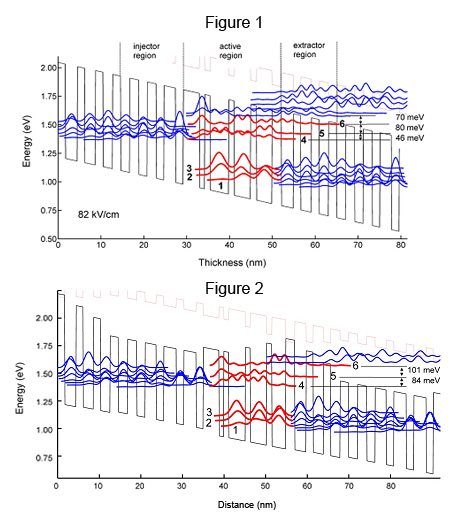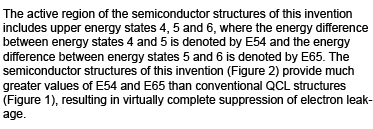Analytical Instrumentation, Methods & Materials

High Power, High Efficiency Quantum Cascade Lasers with Reduced Electron Leakage
WARF: P100284US01
Inventors: Dan Botez, Jaecheol Shin
The Wisconsin Alumni Research Foundation (WARF) is seeking commercial partners interested in developing deep-well quantum cascade lasers that operate efficiently with lower temperature sensitivity, at higher continuous-wave power levels and with longer-term reliability than conventional quantum cascade lasers.
Overview
Quantum cascade lasers (QCLs) are made of layered semiconductor materials. The structures’ cores are composed of tens of stages, each of which consists of three regions: an electron injector, an active region and an electron extractor. Conventional QCLs have quantum wells and barriers of the same alloy composition in all three regions. Devices that are optimized for high continuous-wave (CW) power and emit in the 4.5 to 5.0 µm range experience substantial electron leakage as evidenced by a high sensitivity to temperature variations of both their threshold current and slope efficiency when operating at or above room temperature.
Previous deep-well QCLs conceived by Professor Botez have deeper wells and taller barriers in the active region than those in the injector region. This allows for less electron leakage at and above room temperature, but with the tradeoff of a reduction in laser transition efficiency, which causes the devices to have the same threshold current at room temperature as conventional QCLs. A method or apparatus to overcome this tradeoff in transition efficiency is needed.
Previous deep-well QCLs conceived by Professor Botez have deeper wells and taller barriers in the active region than those in the injector region. This allows for less electron leakage at and above room temperature, but with the tradeoff of a reduction in laser transition efficiency, which causes the devices to have the same threshold current at room temperature as conventional QCLs. A method or apparatus to overcome this tradeoff in transition efficiency is needed.
The Invention
UW-Madison researchers have developed a deep-well QCL in which the active region has barriers that are taller than those in the injector region and increase in height from the injection barrier to the exit barrier. This design significantly reduces the electron leakage, while maintaining the same laser-transition efficiency as in conventional QCLs. The threshold current at room temperature decreases by about 25 percent compared to that for conventional QCLs. The combination of low threshold-current values and virtually suppressed electron leakage leads to significantly higher front-facet or single-facet CW wallplug efficiencies (e.g., about 22 percent) at room temperature. As a result, QCLs operating at higher CW powers with higher CW wallplug efficiency as well as significantly better long-term reliability can be achieved.
Applications
- May be used in combination with laser devices in the mid- to far-infrared wavelength ranges for applications ranging from environmental monitoring to remote detection of explosives and missile-avoidance systems in both commercial and military air vehicles
Key Benefits
- Electro-optical characteristics are significantly less sensitive to temperature.
- Higher CW power and CW wallplug efficiency
- Increased long-term reliability at watt-range powers levels
Stage of Development
The development of this technology was supported by WARF Accelerator. WARF Accelerator selects WARF's most commercially promising technologies and provides expert assistance and funding to enable achievement of commercially significant milestones. WARF believes that these technologies are especially attractive opportunities for licensing.
Additional Information
For More Information About the Inventors
Related Technologies
Publications
For current licensing status, please contact Michael Carey at [javascript protected email address] or 608-960-9867
- Botez et al. 2011. The Temperature Dependence of Key Electro-Optical Characteristics for Mid-Infrared Emitting Quantum Cascade Lasers. Proc. SPIE Novel In- Plane Semiconductor Lasers X Conf. 7953, 79530N-79530N-12.
- Botez D., Kumar S., Shin J.C., Mawst L.J., Vurgaftman I. and Meyer J.R. 2010. Temperature Dependence of the Key Electro-Optical Characteristics for Mid-Infrared Emitting Quantum Cascade Lasers. Appl. Phys. Lett. 97, 071101.
- Shin J.C., D’Souza M., Liu Z., Kirch J., Mawst L.J., Botez D., Vurgaftman I. and Meyer J.R. 2009. Highly Temperature Insensitive, Deep-Well 4.8 μm Emitting Quantum Cascade Semiconductor Lasers. Appl. Phys. Lett. 94, 201103-3.
- Shin J.C., Mawst L.J., Botez D., Vurgaftman I. and Meyer J.R. 2009. Ultra-Low Temperature Sensitive Deep-Well Quantum Cascade Lasers (λ=4.8 µm) via Uptapering Conduction Band Edge of Injector Regions. Electron. Lett. 45, 741-743.
Figures

